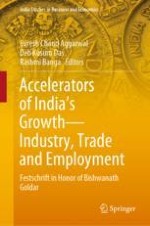2020 | OriginalPaper | Chapter
Increasing Dualism in Indian Wage Labour Market
Authors : Sandip Sarkar, Balwant Singh Mehta
Published in: Accelerators of India's Growth—Industry, Trade and Employment
Publisher: Springer Singapore
Activate our intelligent search to find suitable subject content or patents.
Select sections of text to find matching patents with Artificial Intelligence. powered by
Select sections of text to find additional relevant content using AI-assisted search. powered by
